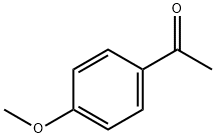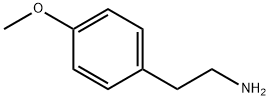A5377112
4-Methoxyacetophenone , 99% , 100-06-1
Synonym(s):
p-Acetanisole;4′-Methoxyacetophenone;4-Acetylanisole
CAS NO.:100-06-1
Empirical Formula: C9H10O2
Molecular Weight: 150.17
MDL number: MFCD00008745
EINECS: 202-815-9
| Pack Size | Price | Stock | Quantity |
| 25G | RMB23.20 | In Stock |
|
| 100G | RMB40.80 | In Stock |
|
| 250g | RMB79.20 | In Stock |
|
| 500G | RMB136.00 | In Stock |
|
| 2.5kg | RMB552.00 | In Stock |
|
| others | Enquire |
Update time: 2022-07-08
PRODUCT Properties
| Melting point: | 36-38 °C (lit.) |
| Boiling point: | 152-154 °C/26 mmHg (lit.) |
| Density | 1.08 |
| vapor pressure | 0.42Pa at 20℃ |
| refractive index | 1.5470 (estimate) |
| FEMA | 2005 | ACETANISOLE |
| Flash point: | >230 °F |
| storage temp. | Keep in dark place,Sealed in dry,Room Temperature |
| solubility | H2O: soluble2.474g/L at 20°C |
| form | Crystals or Crystalline Powder |
| color | White |
| Odor | at 100.00 %. sweet hawthorn anisic powdery balsamic acacia |
| Odor Type | anisic |
| biological source | synthetic |
| Water Solubility | insoluble |
| Sensitive | Light Sensitive |
| JECFA Number | 810 |
| BRN | 742313 |
| InChIKey | NTPLXRHDUXRPNE-UHFFFAOYSA-N |
| LogP | 1.79 at 20℃ |
| CAS DataBase Reference | 100-06-1(CAS DataBase Reference) |
| NIST Chemistry Reference | Acetophenone, 4'-methoxy-(100-06-1) |
| EPA Substance Registry System | 4'-Methoxyacetophenone (100-06-1) |
Description and Uses
4'-Methoxyacetophenone is a solid, pale yellow flavoring agent with a hawthornlike odor. It is soluble in most fixed oils and propylene glycol, and it is insoluble in glycerin and mineral oil. It is obtained by chemical synthesis. This flavoring substance or its adjuvant may be safely used in food in the minimum quantity required to produce its intended flavor. It can be used alone or in combination with other flavoring substances or adjuvants. It is also termed p-methoxyacetophenone.
Safety
| Symbol(GHS) |  GHS07 |
| Signal word | Warning |
| Hazard statements | H302 |
| Precautionary statements | P264-P270-P301+P312-P501 |
| Hazard Codes | Xn |
| Risk Statements | 22-38-36/38-20/21/22 |
| Safety Statements | 37-37/39-26-36 |
| WGK Germany | 2 |
| RTECS | AM9240000 |
| TSCA | Yes |
| HS Code | 29145000 |
| Hazardous Substances Data | 100-06-1(Hazardous Substances Data) |
| Toxicity | The acute oral LD50 value in rats was reported as 1.72 g/kg (1.47-1.97 g/kg) (Moreno, 1973). The acute dermal LD50 value in rabbits was reported as > 5 g/kg (Moreno, 1973). |





